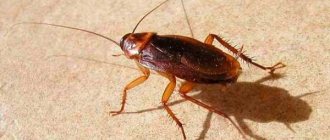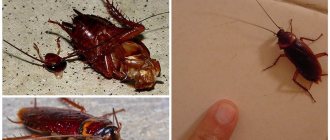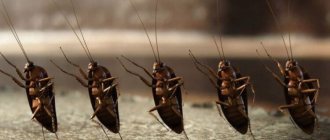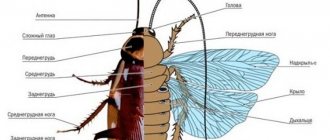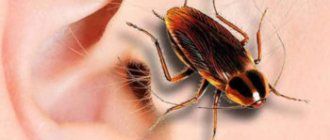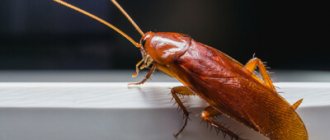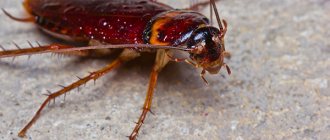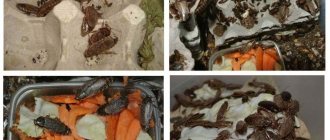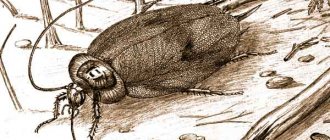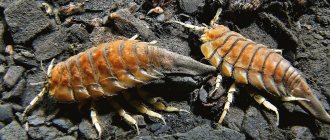Types of cockroaches
| Giant burrowing cockroach | |
| Scientific classification | |
| Kingdom: | Animalia |
| Type: | Arthropods |
| Class: | Insect |
| Order: | Blattodea |
| Family: | Blaberidae |
| Subfamily: | Geoscapheinae |
| Genus: | Macropanestia |
| Variety: | M. rhinoceros |
| Binomial name | |
| Macropanestia of the rhinoceros Saussure, 1895 | |
Giant burrowing cockroach
(
Macropanesthia rhinoceros
) is also known as
the rhinoceros cockroach
and
the Queensland giant cockroach
. These cockroaches are native to Australia and are mainly found in tropical and subtropical parts of Queensland. They are the heaviest cockroach species in the world and can weigh up to 30–35 grams [1] [2] and reach 7.5–8 cm (3.1 in) in length. [1] It is a member of the Blaberidae family, which contains hundreds of species. It is part of the blaberid subfamily Geoscapheinae. [3] [4] It is popular in the wild and can also be sold and kept as a pet.
Unlike some other cockroaches, the giant burrowing cockroach does not have wings and is not considered a pest. This species plays a vital role in the ecosystem by consuming dead leaves, particularly eucalyptus, and processing other substances. They can burrow into the soil to a depth of about 1 m (3 ft 3 in)[1], where they build permanent homes and feed on collected dry leaf litter. The giant burrowing cockroach is the only cockroach in the world that has permanent burrows in the soil. [5] This species plays an important ecological role by promoting nutrient recycling in the wild.
The cockroach is popular in Brisbane and is often sold as a pet. [6]
Description[edit]
Giant burrowing cockroach
The giant burrowing cockroach can be recognized by its large size and weight. An adult can reach more than 60 mm [7], 75–80 mm and weigh up to 30–35 grams. The pronotum is a prominent plate-like structure that covers the first segment of the thorax, has short tubercles on its sides, and can exceed 15 mm. Their pronotum helps dig, acting like a shovel [7], while its abdomen rests on the ground. [8] Cockroaches use their spiny shins to dig and burrow into the ground. The giant burrowing cockroach is well adapted for digging and burrowing, with large hind legs and a tough body armor that provides protection from predators. This is one of the few Australian cockroaches without wings, and at the same time lacking mobility. [9] It is nocturnal. [4]
Adult males and females can be distinguished by the size of the "scoop" on the pronotum that covers the head; Males have a much more pronounced noctuid. They grow by molting several times before reaching full size. When a cockroach molts, it will be pure white except for the eyes. [3] The life expectancy of people in captivity is up to ten years. Adult males are more common than females. [10]
Like other hemimetabolous insects, the immature stages of giant burrowing cockroaches are called nymphs. Nymphs are creamy white at birth but soon turn reddish brown. Both adult females and males are dark brown. Nymphs stay with their mother for five to seven months, and she feeds and cares for them. [3] [5]
Madagascar hissing, 6-10 cm
Some people consider this insect to be a real monster, while others happily grow it at home in an aquarium. The temperament of this cockroach is very unfriendly, and combined with hard wings, it becomes a completely unkind pet.
from the Madagascar hissing cockroach , but they are still bought quite often. They reach a length of 10 centimeters in adulthood. It's about the size of a small mouse. Therefore, this cockroach tops our list of the largest in the world.
His homeland is Madagascar. It is there that he moves freely along the leaves of trees in the dark. It is not expensive to keep such a giant; they are omnivores, so they happily eat various vegetables, fruits and herbs. But if you purchased more than 30 pieces, then you will need a large terrarium with a lid.
4 3
Distribution and habitat[edit]
Macropanethis rhinoceros in captivity
Species of giant burrowing cockroaches are primarily found in Queensland, Australia. It is usually found along the coast between Rockhampton and Cooktown. The cockroach can also be found in the Whitsunday Islands. [3]
The species builds burrows that can extend up to one meter underground [11] where it stores food and resides permanently. The depth of the burrow varies depending on the type of soil, with the length of the burrows ranging from 10 cm underground to 100 cm. [10]
It is common in arid eucalyptus
forests in northeastern Australia. There are 18 known geographical populations of cockroaches in subtropical Queensland. [9] The cockroach has a wide geographic distribution compared to other species of burrowing cockroaches. [12] [13] [14] He is present at a distance of a thousand kilometers. The cockroach can be found in both dry and wet areas of Australia. Common dry areas in which it is found include Maiden Springs, Bundera and Alpha. Common wet areas where the cockroach is found include Cooktown, Magnetic Island and the Whitsundays. Places that fall between the dry and wet regions where the cockroaches live include Coen, Rochford Scrub and Mount Garnet. [14]
Cockroach populations may be isolated geographically due to unsuitable soil or water. This species prefers drier savanna areas west of the Great Dividing Range. [9]
The most common vegetation where cockroaches are found is eucalyptus
forests and grass. [10]
Tiger Madagascar cockroach, 6-7 cm
This insect is most often grown at home. The body length of the Madagascar cockroach is 6-7 centimeters, males are slightly wider than females. They live in Madagascar in arid tropical forests. They prefer rotting fruits and other decaying vegetation as food.
At home, they should be kept in large terrariums with a lid. Moreover, the size of the terrarium completely affects the reproduction rate. You should not place more than one male for several females in one container. It is better to feed with juicy fruits and do not forget about the beneficial substances that the body needs.
Behavior[edit]
The cockroach remains underground because it constantly lives in its burrows. The cockroach often surfaces in wet weather, with most of the activity occurring during the summer rains. During the dry season, it remains in burrows and feeds on collected litter. It feeds mainly on dry, decaying eucalyptus leaves. The cockroach composts the leaves in the hole with bark and dry grass. [4]
Burrows often consist of grass, tree roots and leaves. The entrance to cockroach burrows resembles a flattened semicircle. Burrows can be identified when the cockroach was active, but are often covered with litter or collapsed. The size of the burrow entrance is approximately five centimeters wide and two centimeters high. The burrows often follow a path just below the soil surface to a depth of one meter, and sometimes descend sharply. Burrows don't follow a pattern. The cockroaches occupy the end of the burrows, which expand up to one meter wide to accommodate the collected droppings. Other species of insects have been found in the burrows, including scarabs, aleculid beetles, silverfish, tenebryonid larvae and vermiform moths, as well as other species of cockroaches. [10]
Social behavior[edit]
The cockroach is generally solitary, but young nymphs remain with their mother for several months after birth. The cockroach is active after sunrise and may begin burrowing and digging. Males wander outside their burrows more often than females. Males tend to wander around looking for a mate, while females scoop up droppings to take back to their burrows. [10]
Foraging is common with reared female cockroaches, and the cockroach may wander up to 50 cm from the burrow entrance to collect bedding. It collects mostly dead leaves and uses its jaws to drag litter back into the burrow.
Adult males often engage in fights, but adult females with nymphs are also very aggressive. Aggression is associated with his solitary existence. [10] Aggressive behavior may include hitting, kicking, and hissing, which often causes the cockroach to topple over. Males may fight at the entrances of burrows to prevent other male cockroaches from entering the burrows. During combat, males use the anterior part of the pronotum to push back the intruder. When a giant burrowing cockroach fights another, a hissing sound is made.
Sounds[edit]
A cockroach can make a hissing sound both when breeding and when threatened. The hissing is caused by the expulsion of air from the cockroach's spiracles, which are the external breathing opening on the abdomen. [15]
Interesting facts about the Indian rhinoceros:
- The permanent neighbors of the Indian rhinoceros are birds, for example, herons, mynah starlings, and bee-eaters. They catch insects that the rhinoceros scares away, or peck ticks on its skin.
- The Indian rhinoceros was the first rhinoceros to be seen by Europeans. The first known image of this animal was created by Dürer. The artist created his engraving “Rhinoceros” without seeing the animal, so it looks a little strange, as if “chained” in iron armor. This Indian rhinoceros was brought to Lisbon in 1513 from India from the Rajah of Cambay as a gift to the Portuguese King Manuel I. It was later put on public display and sent as a gift to the Pope. But during transportation, the ship and the rhinoceros sank during a storm.
Angry Rhino
- Rhino hunting was a popular pastime among Indian feudal lords. Miniatures of the 16th-17th centuries. depict the padishahs of the Mughal dynasty hunting rhinoceroses on elephants.
- The main threat to the Indian rhinoceros population has become poaching, which is associated with legends about the miraculous power of its horn. Residents of Asia endowed it with aphrodisiac and anti-poison properties. Therefore, the price of horns on the black market is very high, and poor Asians are trying to get rich through illegal hunting. In this regard, in India in the 70-80s of the last century, strict laws were passed to protect Indian rhinoceroses.
Video
https://youtube.com/watch?v=SfcCMaESX2I
Sources
- https://ru.wikipedia.org/wiki/Indian_rhinohttps://o-prirode.ru/indijskij-nosorog/https://natworld.info/zhivotnye/indijskij-nosoroghttps://www.poznavayka.org/zoologiya/ nosorog-podslepovatyiy-gigant/https://nashzeleniymir.ru/rhinoceroshttps://wild-animals.ru/article/mammals-animals/indiyskiy-nosorog.htmlhttps://fb.ru/article/252172/indiyskie-nosorogi- opisanie-sreda-obitaniya-foto
Biology [edit]
Play[edit]
Reproductive behavior of cockroaches usually occurs at night and is based primarily on smell, taste and touch. Male cockroaches attempt to court females through movements such as hissing, changing posture, moving their antennae, grooming the female, and pushing the female with their body in an attempt to lift the female. It is unknown whether female cockroaches engage in multiple matings, and if so, whether these are with different male cockroaches. [9] Females can have up to thirty young at a time each year. [3]
This species is ovoviviparous [4], meaning that it produces young by eggs that hatch from within the parent. Unlike most egg-laying insects, the female giant burrowing cockroach gives birth to her young and protects her young in her underground niche, providing them with leaf litter that she collects overnight. [14] Cockroaches can live up to 10 years. [2] This species is often found with mothers and cubs together in burrows, while males are largely absent from the burrows.
The rearing cycle of a giant burrowing cockroach can last up to 6 months or until the nymphs are able to leave and build their own burrows and fend for themselves. [4] One brood of approximately thirty nymphs is produced each year, and they typically emerge in late spring after an incubation period of approximately three months. [10] Cockroaches shed their outer skin approximately fourteen times during their life cycle. This skin is often ingested as it is nutritious. [3]
Young nymphs are rarely found above ground, outside the burrow. [10] The nymphs grow at the same rate, and once the nymphs leave the nest, they live alone until it is fully developed and mature. [16]
Obesity [edit]
Depending on the temperature, they have different feeding patterns, carbon dioxide production [17] and metabolic rates. [11] Macropanesthia rhinoceros
a diagnosis of obesity may be made when there is no change in his economy. When a person is nutritionally deficient, they tend to adopt a “thrifty phenotype,” which prioritizes fat accumulation before reproductive development, in order to be able to cope with hazardous environmental conditions. Under optimal environmental conditions, this thrifty phenotype can become maladaptive, leading to excessive fat accumulation and metabolic dysfunction. In the future, this can lead to obesity or metabolic disorders. Obesity can cause "an atypical body type with narrow, elongated abdominal profiles compared to the wide, flat bodies of neighboring congeners." In addition, soft and pale tissue is exposed between the abdominal sclerites. [4]
Turtle cockroach, 2.5 -4 cm
This is a family of cockroaches whose length reaches 4 centimeters. As a rule, everyone is accustomed to considering the presence of cockroaches a sign of unsanitary conditions. But these round insects are highly valued because they have a beneficial effect on health.
They are found in eastern countries and do not cause any hostility among the inhabitants. Most often they are born wingless, but there are exceptions.
If a turtle cockroach has settled in your apartment, then you can be sure that he is far from alone there. They always gather in large flocks and quickly scatter into dark corners if they are noticed. This scene is like a horror movie. Getting rid of these insects at home can be very difficult.
Relationships with people[edit]
Like pets[edit]
The cockroach is calm and easy to care for, making it a common and popular pet. The species cannot move quickly or fly. Its large size, sedentary lifestyle and limited maintenance requirements are contributing to the species' growing popularity as a pet both in Australia and overseas. [4] They are clean, disease-free, odorless, do not bite when handled, do not climb or fly. [3]
Males can be aggressive towards other males, meaning that a larger enclosure will be needed to house more than one cockroach at a time to avoid conflict. There should be more females than males in one enclosure, otherwise conflict may arise between the males over the females.
Enclosures should not be exposed to direct sunlight for long periods of time.
The aquarium or terrarium should have fine to medium-sized clean river sand, with one end wet and the other end of the enclosure dry. The cockroach requires a substrate up to 100 mm deep, which the cockroach uses with leaves and sticks for nests and burrows. The substrate is changed regularly after several months, taking into account the size of the tank and the number of cockroaches present. [3]
The giant burrowing cockroach lived in captivity for a maximum of eight years.
In the wild, nymphs grow faster than in captivity. Wild nymphs can reach their eighth instar in five months, but growth rates can vary greatly, with some nymphs taking up to a year to reach their ninth instar. It has nine stages of age. [4] Laboratory evidence shows that it is a slow-growing cockroach with variable growth rates.
The cockroach eats dried eucalyptus leaves and may also eat fruits and vegetables. [3]
American cockroach, 5 cm
This is one of the most popular cockroaches. The most memorable thing about him is the wings that grow on his back to the envy of the elves. A flying cockroach measuring 5 centimeters in size is far from the dream of residents of small apartments or houses.
The American cockroach is much older than the dinosaurs and has not changed much over the years. This species owes such a long life to its unpretentiousness. It's about food. Many sighted creatures need certain substances to maintain good vision, but this fact has escaped the American cockroaches.
They may not receive important components for several years and can see well in the dark. For many scientists, these cockroaches are a real mystery, so they are still being studied very carefully.
Threats[edit]
The biggest threat to the giant burrowing cockroach is habitat destruction. Their main habitat is forests and lands in northern Queensland, which have been intensively logged since 2000.
Large centipedes find refuge in cockroach burrows and can prey on young nymphs. [10] Large spiders also consume young nymphs. Neither spiders nor most centipedes can eat adults due to their outer shell [16], but adults of Ethmostigmus rubripes
are likely to be able to prey on adult cockroaches.
Marbled cockroach, 2.5-3 cm
This is a versatile insect that can survive in any conditions, but prefers warmer temperatures. They are often bred and kept at home. By the way, they say that if a marbled cockroach escapes from a container or jar, then it will not stay in the house for a long time. They eat absolutely everything, but when they are full they become more or less picky about what they eat. They reach a length of 2.5-3 centimeters.
Links[edit]
- ^ abc "Rhinoceros cockroach...as a pet?" . Archived from the original on August 7, 2011. [ self-published source?
] [
unreliable source?
] - ^ ab "Pet Facts: Giant Digging Cockroaches". Australian Broadcasting Corporation. Retrieved October 7, 2005.
- ^ abcdefghi Sydney TAFE Institute. A Guide to Raising a Giant Burrowing Cockroach
. (2006), pp. 6-24. Accessed March 17, 2022 - ^ B s d e g h - Hill, A. (2016). Obesity and gastrointestinal damage in giant burrowing cockroaches ( Macropanesthia rhinoceros
): a potential effect of the thrifty phenotype.
Journal of Exotic Pet Medicine
,
25
(1), 30–33. https://doi.org/10.1053/j.jepm.2015.12.008 - ^ ab Hasenpusch, S. Giants of the insect world. Land for Queensland Wildlife
. Retrieved from https://www.insectfarm.com.au/newsletters/news200105.php - Jump up
↑ Copeland, Marion (2003). Cockroach. London: Reaction Books. paragraph 62. ISBN 1-86189-192-X. - ^ab Renz, David. A Guide to the Cockroaches of Australia
. CSIRO Publishing, (2014), pp. 98-99. - Day, M. (1949). Histology of the very large insect
Macropanesthia rhinoceros
Sauss.
(Blattidae) . Retrieved from https://www.publish.csiro.au/bi/pdf/BI9500061. - ^ a b c d Brown, West Virginia; Rose, Hawaii; Lacey, M.J.; Wright, K. (2000). "Cuticular hydrocarbons of the giant soil-burrowing cockroach Macropanesthia rhinoceros
Saussure (Blattodea: Blaberidae: Geoscapheinae): analysis in relation to age, sex and location."
Comparative biochemistry and physiology
B.
127
(3):261–77. DOI: 10.1016/S0305-0491(00)00212-1. PMID 11126757. - ^ abcdefghi Rugg, D., Rose, H., & Rugg, D. (1991). Biology of Macropanesthia rhinoceros
Saussure (Dictyoptera: Blaberidae).
Annals of the Entomological Society of America
,
84
(6), 575–582. https://doi.org/10.1093/aesa/84.6.575 - ^ a b Xu, Liangwen; Snelling, Edward P.; Seymour, Roger S. (November 2014). "The burrowing energy of the giant burrowing cockroach Macropanesthia rhinoceros: an allometric study." Journal of Insect Physiology
.
70
: 81–87. DOI: 10.1016/j.jinsphys.2014.09.005. PMID 25257537. - Jump up
↑ Roth, L. M. (1977). Taxonomic revision of the Panesthiinae of World I: Panesthiinae of Australia (Dictyoptera: Blattodea: Blaberidae). Australian Journal of Zoology (Supplementary Series No.) 48, 1–112. - Walker, J. A., Rugg, D., & Rose, H. A. (1994). Nine new species of Geoscapheinae (Blattodea: Blaberidae) from Australia. Queensland Museum Memories 35, 263–284.
- ^ abc Jex, A.R.; Schneider, M.A.; Rose, Hawaii; Cribb, T. H. (2007). "Local climate aridity influences the distribution of plastomatoid nematodes in the Australian giant burrowing cockroach." Parasitology
.
134
(10):1401–1408. DOI: 10.1017/S0031182007002727. PMID 17445327. - ↑
Heathcote, Angela.
"Australian giant burrowing cockroaches actually hiss." Australian Geographic
, (2020), https://www.australiangeographic.com.au/topics/wildlife/2018/05/australias-giant-burrowing-cockroaches-actually-hiss/. - ^ ab Tadao, M. (1992). Family association, nymphal development and population density of the Australian giant burrowing cockroach, the rhinoceros Macropanesthia (Blattaria: Blaberidae). Zoological science.
,
9
, 835-842. doi: https://biostor.org/reference/207751 - Woodman, James D.; Cooper, Paul D.; Haritos, Victoria S. (May 2007). "Cyclic gas exchange in the giant burrowing cockroach, Macropanesthia rhinoceros: influence of oxygen pressure and temperature". Journal of Insect Physiology
.
53
(5):497–504. DOI: 10.1016/j.jinsphys.2007.01.012. PMID 17374539.
What does rhea eat?
Photo: Rhea ostrich
Rheas eat anything they can grab and swallow. But the basis of their diet (more than 99%) is still plant foods.
They are eating:
- leaves of dicotyledonous (usually) plants, both native and introduced from the families Amaranthaceae, Asteraceae, Bignonaceae, Brassicas, Leguminosae, Lamiaceae, Myrtleaceae and Solanaceae, can be eaten by thorns, which are avoided by sheep;
- dry and juicy fruits, seasonal seeds;
- tubers;
- grains in the fields or eucalyptus leaves on plantations are eaten only occasionally, which partly saves them from the wrath of farmers;
- invertebrates, making up 0.1% of the diet, and young animals like such food more than adults;
- vertebrates, which make up less than 0.1% of the diet.
To grind and better digest plant food, the bird needs pebbles, preferably pebbles, but at the same time the rhea, like the African ostrich, swallows various shiny objects made of metal and other materials.
Further reading[edit]
| Wikimedia Commons has media related to Rhinoceros Macropanesthia . |
| Wikispecies has information related to Rhinoceros Macropanesthia . |
- Jex, A. R.; Schneider, M.A.; Rose, Hawaii; Cribb, T. H. (2007). "Local climate aridity influences the distribution of plastomatoid nematodes in the Australian giant burrowing cockroach." Parasitology
.
134
(10):1401–8. DOI: 10.1017/S0031182007002727. PMID 17445327. - Woodman, James D.; Cooper, Paul D.; Haritos, Victoria S. (2007). "Cyclic gas exchange in the giant burrowing cockroach, Macropanesthia rhinoceros: influence of oxygen pressure and temperature". Journal of Insect Physiology
.
53
(5):497–504. DOI: 10.1016/j.jinsphys.2007.01.012. PMID 17374539. - Brown, West Virginia; Rose, Hawaii; Lacey, M.J.; Wright, K. (2000). "Cuticular hydrocarbons of the giant soil-burrowing cockroach Macropanesthia rhinoceros Saussure (Blattodea: Blaberidae: Geoscapheinae): analysis in relation to age, sex and location." Comparative biochemistry and physiology
B.
127
(3):261–77. DOI: 10.1016/S0305-0491(00)00212-1. PMID 11126757.
| Taxon identifiers |
|
Natural enemies of the warthog
Photo: African warthog
All African predators feed on warthogs. Most often this is:
- groups of lionesses or young lions. They prefer to select young or weakened individuals, avoiding groups of strong, healthy warthogs;
- cheetahs also prefer small piglets;
- leopards are the most terrible enemies of warthogs, since they deftly climb trees and are perfectly camouflaged in the grass;
- hyenas can even attack a group of warthogs;
- crocodiles lie in wait for them at a watering hole;
- eagles and vultures drag away newborn cubs;
- Hippos and rhinoceroses are also dangerous, as they can attack pigs if there are cubs near these herbivores.
If a warthog sees danger, but there are cubs nearby that are worth protecting, it may rush to attack the rhino or elephant. Even small piglets can react aggressively to predators: there have been cases when a piglet attacked young lions in response, which put the predators into a state of shock, and they retreated.
Warthogs' hearing and sense of smell are acute, but their vision is weak. Therefore, they prefer to lead a daytime lifestyle, when they can not only hear the enemy, but also see him. While feeding, a warthog may encounter a black mamba, causing it to die from a bite. The greatest danger to warthogs is from people who hunt them for meat and for sport.
[edit] Literature
- S.I. Medvedev. Lamellars (Scarabaeidae). Subfamily Euchirinae, Dynastinae, Glaphyrinae, Trichiinae. Fauna of the USSR. Coleoptera. T. X, issue. 4. M.-L., Ed. Academy of Sciences of the USSR. 1960. 399 p.
- Semenov-Tyan-Shansky A.P. and S.I. Medvedev. 1932. Rhinoceros beetles of the Russian and (Oryctes Ill.) Central Asian faunas (Coleoptera, Scarabaeidae). (With 5 tables). Every year. Zool. Museum of the USSR Academy of Sciences: 481-502, fig. 1-27.
- Edmund Reitter: Fauna Germanica. Die Käfer des deutschen Reiches. Stuttgart: KG Lutz, 1909. Band II. S. 469.
- Big Encyclopedic Dictionary. 2000.
- Great Soviet Encyclopedia. - M.: Soviet Encyclopedia. 1969-1978.
- Encyclopedic Dictionary of F. A. Brockhaus and I. A. Efron. - St. Petersburg: Brockhaus-Efron. 1890-1907.
- Natural science. Encyclopedic Dictionary.
Why is a bite dangerous?
Outwardly, an insect bite does not look dangerous, but in fact it is. The body of an insect crawling in a variety of places is covered with dust and harmful bacteria, which may even include tuberculosis and dysentery bacteria. Having bitten a person, the insect transfers these bacteria to the body of an adult or child, causing an infectious disease.
Due to the tropomyosin protein contained in various insect secretions, many people, after being bitten by a red cockroach, experience an allergic reaction, skin irritation and itching. Such a bite can cause the development of hives, which has the following symptoms: a large number of pale pink blisters appear, the skin at the site of the bite itches and itches. Moreover, ulcers that appear at the site of the bite do not always heal quickly and without problems.
People who have been bitten during illness have a weakened body and wound healing is more difficult. In this case, a scar may appear on the skin, and the wounds themselves sometimes take on the character of a chronic disease. There are also known cases of an asthma attack that began after a cockroach bite.
After an American cockroach bite, multiple ulcers appear on the skin, which can then turn into ulcers that are chronic and difficult to cure.
Historical area
Javan rhinoceroses once ranged across much of Southeast Asia, from Calcutta in India, throughout Bangladesh, Southern China, Laos, Vietnam, Cambodia, Thailand, Peninsular Malaysia, Sumatra and western Java. They were also found in Borneo about 12,000 years ago and in most of China about 2,000 years ago.
They lived in a variety of tropical landscapes, both lowland and highland, from the mangroves of India and Bangladesh, the mountains of Southern China, to the scrub foothills of the highest volcanoes in Java. The Javan rhinoceros likely had a wider ecological range than its larger relative, the greater one-horned rhinoceros, or its compatriot, the Sumatran rhinoceros.
Appearance of a giant
The largest cockroach in the world reaches a length of 9 cm. The body structure differs from the usual red cockroaches and black cockroaches in the absence of wings. The abdomen consists of clearly visible segments. The color is brown with different shades, black head, long mustache.
Females on average grow up to 7 cm. The male’s body length is about 6 cm. It is quite easy to distinguish the sex of an adult. The female has an elongated abdomen, starting from the head itself; at the end of the body, the last 2 segments are painted black. The male has only the last segment black, his mustache is broken and crooked, as there is a constant struggle for primacy.
Interesting!
The giant cockroach makes sounds similar to the hiss of a rattlesnake. Some scientists believe that the insect hisses in a dangerous situation, at the moment of mating. Others say that hissing occurs due to the characteristics of the respiratory system. When the huge beetle exhales air, it creates a terrifying sound. Males begin to hiss especially loudly during the mating season.
Reproduction
Large Madagascar cockroaches are viviparous species. The female carries the ootheca in the genital bursa of the abdomen. To gain the attention of a partner, males engage in battles. In the heat of battle, opponents' paws or antennae are bitten off. Males push the opponent with cone-shaped outgrowths. The defeated contender falls on his back and gives up the female to the winner.
After fertilization, embryo maturation occurs in the insect's body. A special capsule is formed in the abdomen - the ootheca, in which the eggs are located. Periodically, the female pushes it outside for ventilation. Pregnancy lasts up to two months, its duration depends on temperature - when it gets colder, the appearance of offspring is delayed. 20-50 small larvae emerge from the abdomen of the cockroach. They are white in color, the body is soft, without a shell. During the day, the larvae darken and become covered with a chitinous layer. During the first days, the female stays close to the offspring. Protecting children, she hisses especially sharply and loudly.
Attention. Under unfavorable conditions (low temperature or humidity, lack of food), females shed their ootheca prematurely and the offspring die.
Lifestyle
Insects are active at night, and during the day they hide from the sun under old stumps and leaves. They feed on fallen fruits, flowers, and green parts of plants. The flat, smooth shell serves as protection from attack. It is difficult for predators to grab an insect pressed against the bark. To intimidate the enemy, a sharp hissing sound is made.
In nature, the lifespan is 1.5-2 years. In the absence of enemies and good care, they live 3-5 years. The larva takes six months to mature. During this period, she molts 5-7 times. Shedding her tight chitinous shell, she becomes soft and defenseless for several hours.

